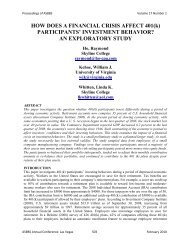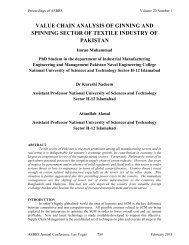stock repurchase announcements: a test of market ... - Asbbs.org
stock repurchase announcements: a test of market ... - Asbbs.org
stock repurchase announcements: a test of market ... - Asbbs.org
You also want an ePaper? Increase the reach of your titles
YUMPU automatically turns print PDFs into web optimized ePapers that Google loves.
Importance <strong>of</strong> Internal Controls<br />
provided by Capt. Smith and the custodial function was accomplished by Lt.Col.<br />
MacKay. This principle remains the cornerstone <strong>of</strong> an effective system <strong>of</strong> internal<br />
controls today.<br />
HISTORICAL INFLUENCES ON CURRENT INTERNAL CONTROLS<br />
The previous review <strong>of</strong> actual Civil War documents emphasizes the importance <strong>of</strong> maintaining an<br />
efficient system <strong>of</strong> controls. The army’s control based accounting system was later replicated by<br />
American businesses. Many <strong>of</strong> the senior <strong>of</strong>ficers from both Union and Confederate armies<br />
entered the business world following the war. They logically employed the accounting and<br />
internal control systems that were familiar to them. Most <strong>of</strong> these men were graduates <strong>of</strong> West<br />
Point who were perhaps the best-trained minds in these subjects. According to Hoskin and Macve<br />
(1988), a new form <strong>of</strong> “managerialism” emerged with these men. In particular, attention to<br />
financial details and a serious attempt to safeguard assets resulted from the emergence <strong>of</strong> these<br />
military <strong>of</strong>ficers as executives in numerous U.S. businesses.<br />
The accounting control system utilized by the army in the Civil War was documented in three<br />
instructional guides. One <strong>of</strong> these was the “Revised Regulations for the Army <strong>of</strong> the United<br />
States” published in 1861 (Regulations, 1861). According to Simon Cameron, Secretary <strong>of</strong> War,<br />
this was the “sole and standing authority” for military operations. The Regulations contained a<br />
description <strong>of</strong> the many types <strong>of</strong> accounting internal controls used by the army. The second<br />
instructional text was “The Quartermaster’s Guide” that was issued near the end <strong>of</strong> the war (Case,<br />
1865). The third and final publication issued for the benefit <strong>of</strong> company accounting clerks was<br />
titled “The Company Clerk” authored by August V. Kautz in 1865. These three publications<br />
emphasized the need to safeguard all <strong>of</strong> the army’s assets and produce accounting reports that are<br />
accurate and reliable. Even at this early time in our history, the army realized that it needed a<br />
system to safeguard all <strong>of</strong> its assets and allow it to operate more efficiently.<br />
The importance <strong>of</strong> internal controls has continued to increase in business firms today. In 1985,<br />
the Committee <strong>of</strong> Sponsoring Organizations (COSO) was formed to sponsor the National<br />
Commission on Fraudulent Financial Reporting. One <strong>of</strong> their first recommendations was that a<br />
comprehensive framework <strong>of</strong> internal control be developed (COSO, 1985). The COSO definition<br />
<strong>of</strong> internal control included five components that are discussed in a majority <strong>of</strong> modern auditing<br />
texts (Rittenberg, 2008). First, the “control environment” or “tone at the top” involves the ethical<br />
climate within the firm. If an ethical climate does not exist at the top management level, the<br />
quality <strong>of</strong> internal controls is likely to be poor.<br />
The second COSO component <strong>of</strong> internal control is “risk assessment.” This involves the<br />
identification <strong>of</strong> material risks within the <strong>org</strong>anization that would hinder the firm from<br />
accomplishing its objectives. The third and fourth elements are “information and communication”<br />
and “monitoring.” These stress the preparation <strong>of</strong> needed information in the form <strong>of</strong> reports and<br />
statements that are communicated to the appropriate managers. The key is “getting the right<br />
information to the right people.” Monitoring involves ongoing efforts to provide feedback on the<br />
effectiveness <strong>of</strong> the entire internal control system. The fifth and final component <strong>of</strong> internal<br />
control is the area <strong>of</strong> “control activities.” These represent a number <strong>of</strong> pervasive internal control<br />
activities that were utilized by the U.S. Army during the Civil War and continue to be <strong>of</strong> prime<br />
importance today (Arens, 2008). These include segregation <strong>of</strong> duties, proper authorization policy,<br />
independent checks, physical safeguards, and adequate documents and records. These activities<br />
are also especially important is the effort to reduce the opportunity for fraud within an<br />
<strong>org</strong>anization (Albrecht, 41).<br />
ASBBS E-Journal, Volume 4, No.1, 2008 86

















